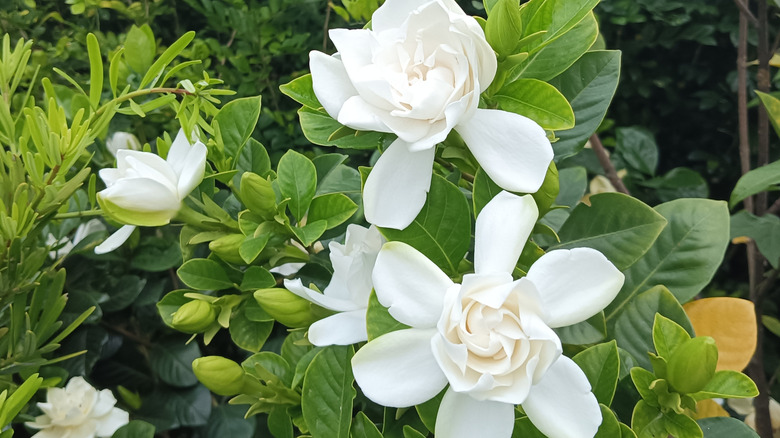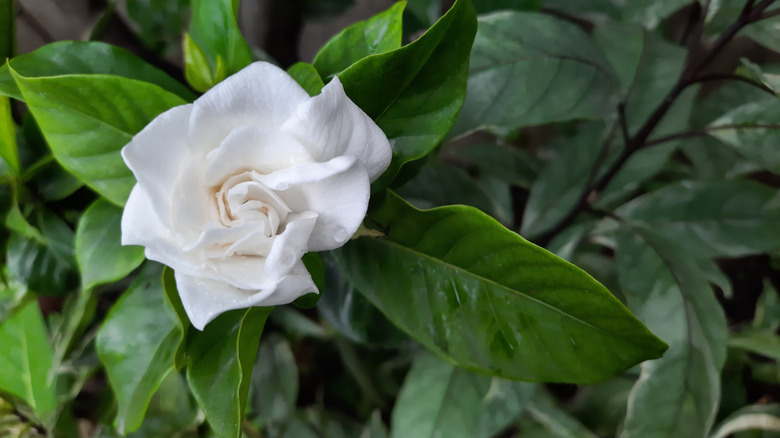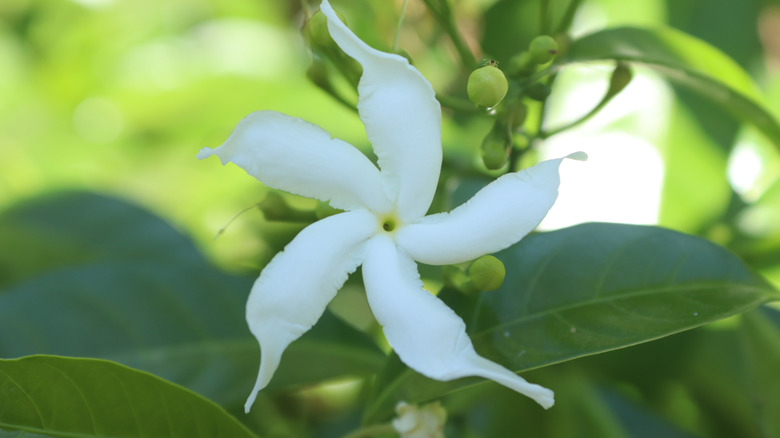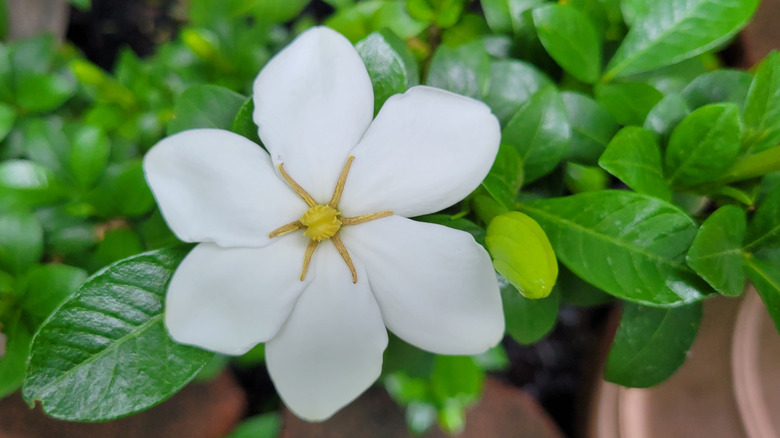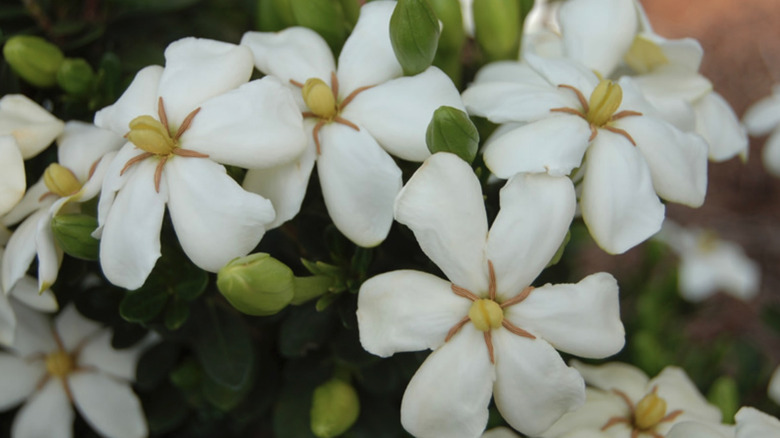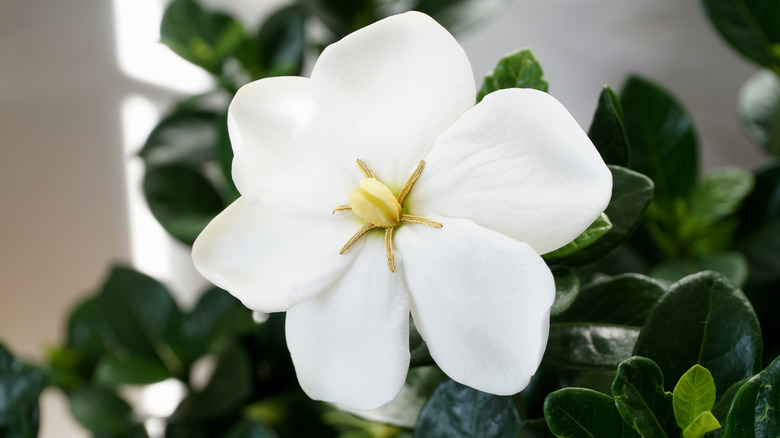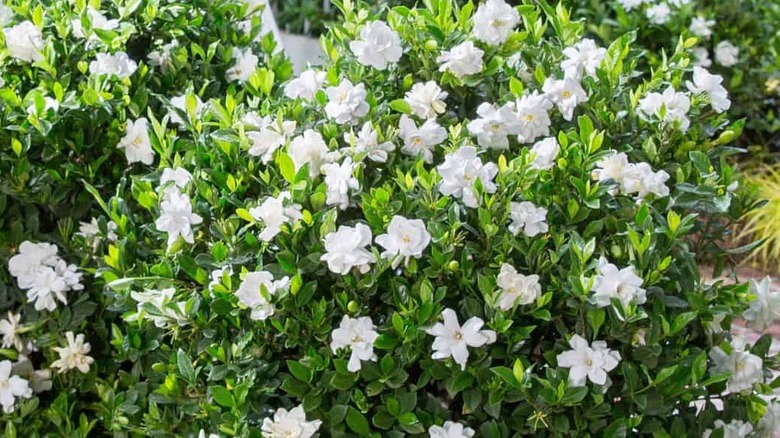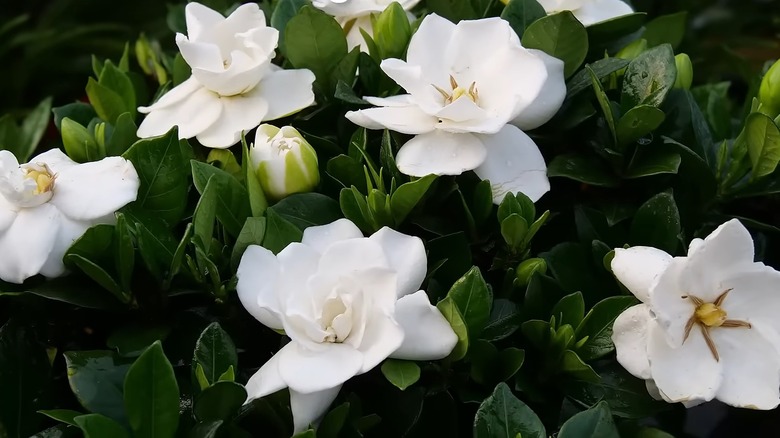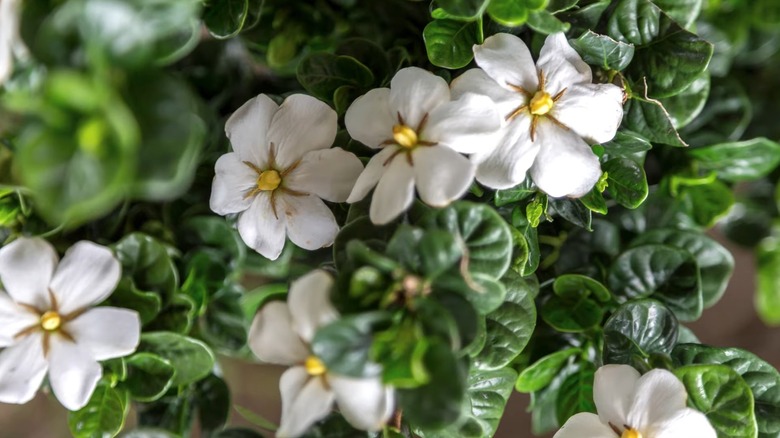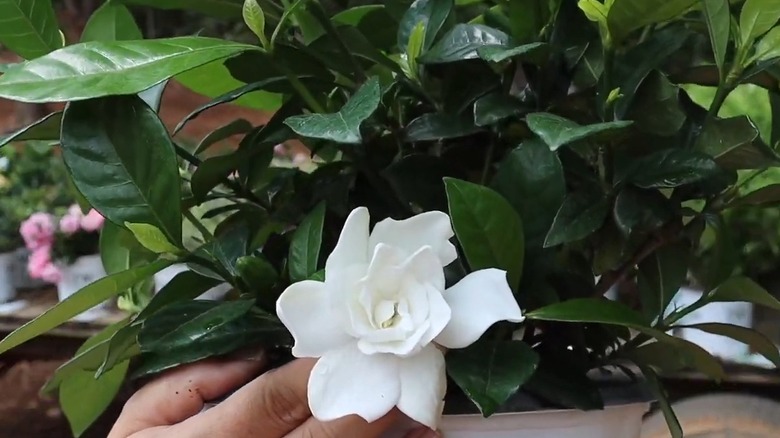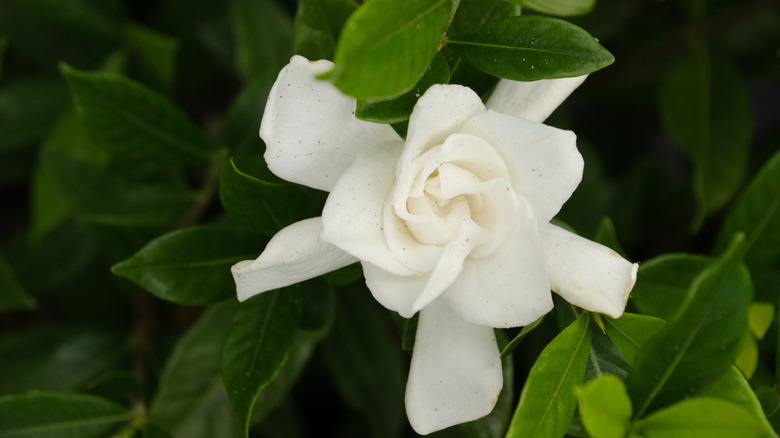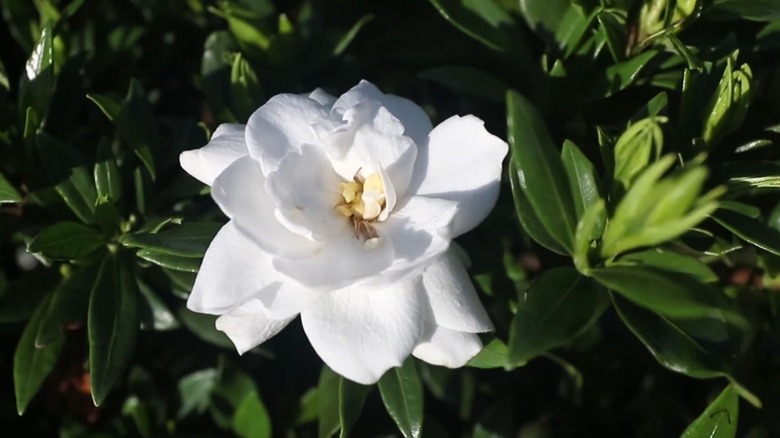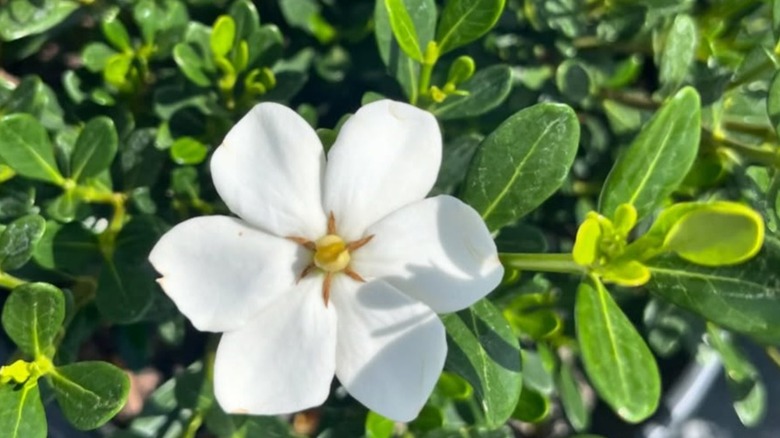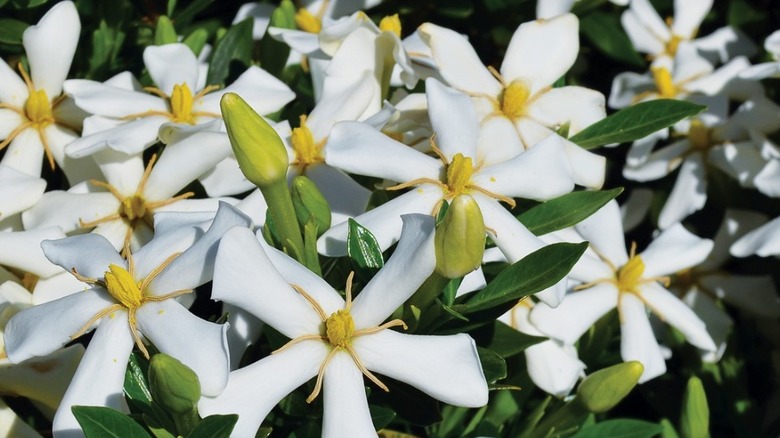17 Varieties Of Gardenia That Can Tolerate The Summer Heat & Winter Frost
For centuries, gardenias have captured our hearts with their pristine white blooms and intoxicating fragrance. But the unfortunate fact remains that their tropical origins don't always allow for much cold resilience. Most gardenias are hardy in USDA zones 8 through 11, forcing gardeners in colder regions to grow them as houseplants or overwinter them indoors. However, with several breeding programs underway, things are changing on the ground. Many new varieties and cultivars, including 'Crown Jewel,' 'Pinwheel,' 'Daisy,' 'Echo Heaven Scent,' and ' Echo Swan Princess,' can now be successfully grown down to zone 6. And the best part is that these cultivars' cold tolerance doesn't take away from their ability to withstand summer heat!
Before planting cold-hardy gardenias, be sure to put them in the ground during spring, so they may develop enough roots by the time winter rolls in. Also, if your climate tends to get too hot, find them a spot with some filtered or afternoon shade. While gardenias certainly love full sun exposure, meaning they need over six hours of direct sunlight, anything more is overkill. Finally, stick to the axiom of "less is more." Like you, a fair variety of insects, including aphids, thrips, and whiteflies, are enchanted by gardenia's fragrance, so unless you want them taking over, limit your plantings. Ready? Here's a quick rundown on gardenia varieties that tolerate the summer heat and winter frost.
Crown Jewel gardenia
If limited acreage is throwing a wrench in your plans to start a pollinator garden, consider 'Crown Jewel' gardenia (Gardenia jasminoides 'Crown Jewel'). It's a compact evergreen perennial that tops out at 3 feet, though it extends much wider. So long as you keep the winter beds mulched, you can grow this hybrid cultivar in zones 6 to 10. 'Crown Jewel' is a heavy bloomer, producing gorgeous white flowers throughout the summer and autumn, followed by fruit. The latter encourages bees, moths, and songbirds to visit your yard, though deer, thankfully, pass these plants over.
Pinwheel gardenia
Where late-season frosts play spoilsport, consider growing 'Pinwheel' gardenia (Gardenia jasminoides 'Pinwheel'), as its buds can withstand such spring shocks. Around late spring, this gardenia shrub's mound is blanketed in perfumed white blooms that remain on display through the summer. Expect another flush in the fall, though it may not be as profuse as the first round. 'Pinwheel' thrives with full and partial sun exposure and is hardy in zones 6 to 11. However, you must water it more during summer extremes so that it can weather the heat well. Mass plant the 4-foot-tall shrub in garden beds or pop it into seasonal planters.
Daisy gardenia
Aptly named, 'Daisy' gardenia (Gardenia jasminoides 'Daisy') unfurls daisy-esque white flowers in late spring, sporting starfish-shaped yellow centers. As the season progresses, each bloom takes on a creamier tone, providing a subtle contrast to the burgeoning new blooms. Snipping off dead flowers will ensure these gardenia shrubs continue blooming until frost. 'Daisy' gardenias can tolerate summer heat, though it's best to plant them on your home's east side, where the sunlight isn't as intense. These deer-resistant shrubs are cold-hardy in zones 7 through 10. When grown for living hedges, space the shrubs 3 feet apart. They're also great contenders for container gardens.
Echo Heaven Scent gardenia
As its name suggests, 'Echo Heaven Scent' gardenia (Gardenia augusta 'Echo Heaven Scent') truly smells divine and, for that reason alone, deserves a spot around your entryway, patio, or walkway. During the spring-summer transition, its green mound is enveloped in white blooms. As fall ushers in, these flowers give way to exquisite red or orange seedpods that look quite ornate. 'Echo Heaven Scent' can tolerate coastal sprays and is cold hardy in zones 6 through 11. If desired, you may train the 6-foot-tall shrub into an espalier.
Summer Snow gardenia
'Summer Snow' gardenia (Gardenia jasminoides 'Summer Snow') can tolerate temperature dips to 0 degrees Fahrenheit (with winter mulch), in addition to heat, humidity, drought, and shade. These attributes make it a worthy planting option in zones 6 to 10, though it's best to plant it in a location with morning or filtered sun. By late spring, waxy, ruffled petals dance above the sea of luscious green foliage, infusing the surrounding air with a sweet fragrance. This snow-like display lasts until summer. This one is a vigorous grower and grows to heights of 5 feet at maturity. Site it in acidic, moist soils.
Kleim's Hardy gardenia
If you're considering dwarf plants for your small garden space, 'Kleim's Hardy' gardenia (Gardenia jasminoides 'Kleim's Hardy') may be one option. Their leafy mound grows no taller or wider than 3 feet, while the slow growth rate promises little pruning maintenance. As their yellow-eyed white blooms are incredibly aromatic, you can put them up in patio containers or plant them in shrub borders. However, make sure there isn't an excessive buildup of reflected heat from surrounding structures. Otherwise, despite their full sun preference, you'll need to offer cover in hot summers. They're hardy in zones 7 through 11.
Echo Swan Princess gardenia
At 2½ feet in height, 'Echo Swan Princess' gardenia (Gardenia jasminoides 'Echo Swan Princess') can be tucked into the tiniest corners or containers for a whiff of heavenly fragrance. Specially hybridized for improved resilience to drought and root diseases, 'Swan Princess' also boasts supreme cold hardiness, enabling its survival in zone 6b. It's a rebloomer, displaying velvety white petals early in spring, with another flush during the summer-fall transition. While you may grow it down south up to zone 11, you must water this evergreen shrub more during the dog days of summer.
Chuck Hayes gardenia
'Chuck Hayes' gardenia (Gardenia jasminoides 'Chuck Hayes') can tolerate temperature drops to between 5 and 10 degrees Fahrenheit, making it suitable for outdoor planting in zones 7 to 11. While it does prefer full sun exposure, during extremely hot summers, it will perform better with afternoon shade. Alternatively, you may plant it underneath tall shrubs or trees that filter out the more intense sun rays. Make sure to site 'Chuck Hayes' in moist, fertile soils — this will encourage faster growth and abundant flowering. Anticipate intensely aromatic, double flowers from late spring until late summer, with an additional flush in the fall.
Jubilation gardenia
Although 'Jubilation' gardenia (Gardenia jasminoides 'Jubilation') is touted as being hardier than most cultivars, its growing range extends between zones 7 and 10, and the plant requires winter protection in the colder end of this range. Gardenia 'Jubilation' intermittently flushes pure white flowers from spring through fall. Given the long blooming season, these gardenias are ideal for foundation beds, as specimens, or to edge borders. However, you must keep deadheading the spent blooms. You don't ever have to worry about pruning these beautiful garden plants as they naturally maintain their shape. Their 4-foot-tall and similarly wide frame can be tucked in containers.
ScentAmazing gardenia
Resilient against sub-zero temperatures, 'ScentAmazing' gardenia (Gardenia jasminoides 'ScentAmazing') is the aromatic shrub to plant if you live in zones 7 to 10. Lance-like leaves render year-round interest, enhanced by white blooms that unfold in late spring and continue to appear through the fall. Unless potted up, you can plant 'ScentAmazing' in hot sites receiving morning sun; however, be prepared to give cover in all-day sun exposure. Although labeled drought-tolerant, these gardenias benefit from summer mulching, as it helps retain water for longer. They grow about 3 feet tall and wide.
Steady as She Goes gardenia
In line with its name, 'Steady as She Goes' gardenia (Gardenia jasminoides 'Steady as She Goes') assures steady blooms throughout spring and summer, provided you site it well. While full sun is tolerated, you must ensure the soil is always moist — dry conditions will prompt bud drop. As such, pruning may not be necessary, save for removing dead and diseased limbs. 'Steady as She Goes' is a heat-tolerant gardenia that's cold-hardy in zones 7 to 10. This flowering shrub can grow about 5 feet tall and 7 feet across, so use it in the back of borders and beds.
Diamond Spire gardenia
Cold hardy to freezing temperatures, 'Diamond Spire' gardenia (Gardenia x 'Diamond Spire') is another heat-tolerant gardenia variety you may consider growing in zones 7 to 10. Since it has a columnar shape — growing no wider than 2 feet at maturity — you can pop it in the narrowest spaces. Otherwise, use it as a vertical accent or an evergreen hedge in patio and balcony containers. Birds and butterflies will visit the white flowers when they're in bloom, come spring, and again in the summer, assuming you haven't cut them all for your indoor bouquets.
Pillow Talk gardenia
Literally smothering its glossy foliage with cloudy white blooms in spring, 'Pillow Talk' gardenia (Gardenia jasminoides 'Pillow Talk') is an unmissable addition when tolerance for heat and humidity is important. Unlike most gardenias, this cultivar can withstand the summer afternoon heat — even in hot climates. Better yet, it is cold hardy to 5 degrees Fahrenheit, which means you can grow it in zones 7 to 10. 'Pillow Talk' has a spicy fragrance, so site it where you can enjoy it. Pruning isn't necessary, save for removing dead wood. Since it grows wider than tall, use it in front borders.
Frostproof gardenia
If you're looking for evergreen hedges and shrubs that provide privacy in winter, consider 'Frostproof' gardenia (Gardenia jasminoides 'Frostproof'). Planted in zones 7 through 11, these 4-foot-wide gardenias form a thick screen that remains resilient to mercurial drops of 5 degrees Fahrenheit. You can even count on the burgeoning buds to withstand spring frosts. Bear in mind, though, that these evergreen shrubs establish slowly. Heaviest blooming occurs in spring, with intermittent displays throughout summer. They also fare well under full sun exposure. Keep them well-watered during summer heat, or they will defoliate.
'Fool Proof' gardenia
Slender, dark green leaves beautifully offset the creamy white flowers of 'Fool Proof' gardenia (Gardenia hybrid 'Fool Proof'), as they appear in spring, and rebloom multiple times during summer and fall. These shrubs can hold their own when temperatures drop to between 0 and 10 degrees Fahrenheit, while the spring buds can brave surprise frosts. They're also heat-tolerant and can be grown in zones 10 to 7. Compared to other gardenias, they exhibit superior pest and disease resistance. 'Fool Proof' grows about 4 feet tall and 3 feet wide. Spread a 2-inch mulch layer around the plant for moisture retention.
Snow Girl gardenia
If you struggle to provide good drainage to your plants because of the heavy clay content in your garden soil, 'Snow Girl' gardenia (Gardenia jasminoides 'Snow Girl') can be an option. This is because it daintily tolerates such mediums. It also has a dense, compact habit, with its mound measuring about 2 feet by maturity. Yellow-eyed, single white flowers appear in early summer, and then in multiple spurts until frost hits. From full sun to moderate shade, 'Snow Girl' gardenia flourishes in diverse conditions. However, when it gets too hot, midday protection can be helpful. It is hardy in zones 7 through 10.
Echo Swan Maiden gardenia
A part of the Gardener's Confidence Collection, 'Echo Swan Maiden' (Gardenia jasminoides 'Echo Swan Maiden') is another cold-hardy gardenia variety that you can plant in zones 6 to 9. Its dark green leaves provide a gorgeous foil for six-petaled white blooms that appear in high abundance in early spring. 'Echo Swan Maiden' is also great at holding on to its maidenly habit as it ages, eventually measuring about 3 feet high and slightly wider. Such dimensions, on top of the heady fragrance and higher disease resistance, make it suitable for foundation beds or entryway accents. You must water it more during extreme heat.
